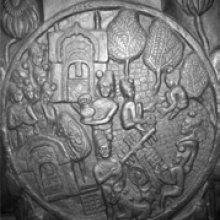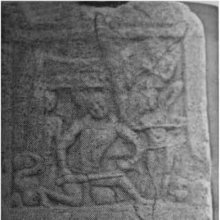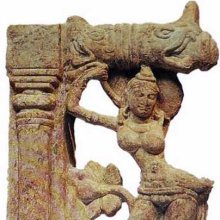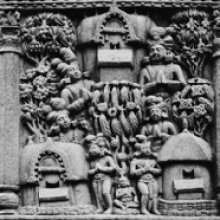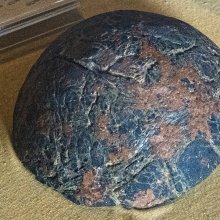Jetavana, Jeta-vana: 8 definitions
Introduction:
Jetavana means something in Buddhism, Pali, Hinduism, Sanskrit, the history of ancient India. If you want to know the exact meaning, history, etymology or English translation of this term then check out the descriptions on this page. Add your comment or reference to a book if you want to contribute to this summary article.
Jetavana has 6 English definitions available.
Images (photo gallery)
(+2 more images available)
Languages of India and abroad
Sanskrit dictionary
[Deutsch Wörterbuch]
Source: Cologne Digital Sanskrit Dictionaries: Böhtlingk and Roth Grosses Petersburger WörterbuchJetavana (जेतवन):—(jeta = jetar + vana) n. Jetar's Wald, Nomen proprium eines Waldes bei Śrāvastī, wo Śākyamuni seine Lehre verkündet, [Rgva tch’er rol pa ed. Calc. 1, 6.] [Lebensbeschreibung Śākyamuni’s 260 (30).] [Burnouf 22. 23.] [Hiouen-Thsang I, 295. 297.]
Source: Cologne Digital Sanskrit Dictionaries: Sanskrit-Wörterbuch in kürzerer FassungJetavana (जेतवन):—n. Nomen proprium eines Waldes.
Sanskrit, also spelled संस्कृतम् (saṃskṛtam), is an ancient language of India commonly seen as the grandmother of the Indo-European language family (even English!). Closely allied with Prakrit and Pali, Sanskrit is more exhaustive in both grammar and terms and has the most extensive collection of literature in the world, greatly surpassing its sister-languages Greek and Latin.
See also (Relevant definitions)
Starts with: Jetavana-thupa, Jetavanaloka, Jetavanarama, Jetavanavihara.
Full-text (+220): Jetavanavihara, Jetarama, Jetasahvaya, Jetri, Mahamanikagama, Shravasti, Anathapindikassarama, Jetuyyana, Gandhakuti, Jotivana, Kosambakuti, Kurundacullaka, Titthiyarama, Jetavaniya, Manakama Sutta, Uttarasailah, Ambala, Apagata Sutta, Cetoparicca Sutta, Sadhu Sutta.
Relevant text
Search found 39 books and stories containing Jetavana, Jeta-vana; (plurals include: Jetavanas, vanas). You can also click to the full overview containing English textual excerpts. Below are direct links for the most relevant articles:
The Jataka tales [English], Volume 1-6 (by Robert Chalmers)
Jataka 462: Saṃvara-jātaka < [Volume 4]
Jataka 75: Maccha-jātaka < [Book I - Ekanipāta]
Jataka 229: Palāyi-jātaka < [Book II - Dukanipāta]
Dhammapada (Illustrated) (by Ven. Weagoda Sarada Maha Thero)
Verse 306 - The Story of Sundarī the Wandering Female Ascetic < [Chapter 22 - Niraya Vagga (Hell)]
Verse 176 - The Story of Cincāmānavikā < [Chapter 13 - Loka Vagga (World)]
Verse 268-269 - The Story of the Followers of Non-Buddhist Doctrines < [Chapter 19 - Dhammaṭṭha Vagga (Established in Dhamma)]
Bihar and Eastern Uttar Pradesh (early history) (by Prakash Narayan)
Gahapatis and Kings < [Chapter 4 - Social Process, Structures and Reformations]
Gahapatis and Brahmanas < [Chapter 4 - Social Process, Structures and Reformations]
The Pattern of Landholding < [Chapter 2 - Economic and Urban Processes]
Vinaya (3): The Cullavagga (by T. W. Rhys Davids)
Cullavagga, Khandaka 6, Chapter 9 < [Khandaka 6 - On Dwellings and Furniture]
Cullavagga, Khandaka 5, Chapter 22 < [Khandaka 5 - On the Daily Life of the Bhikkhus]
Cullavagga, Khandaka 3, Chapter 1 < [Khandaka 3 - Probation And Penance (B)]
The travels of Fa-Hian (400 A.D.) (by Samuel Beal)
The Great Chronicle of Buddhas (by Ven. Mingun Sayadaw)
Chapter 34d - The Buddha’s Twentieth Vassa at Rājagaha < [Volume 4]
Chapter 19b - The Buddha’s Second Vassa < [Volume 3]
Biography (7) (Bahuputtika) Soṇā Therī < [Chapter 44 - Life Histories of Bhikkhunī Arahats]
